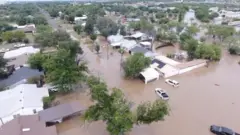Texas Floods: Examining Early Warnings Amidst Devastating Deluge
Texas Floods: Examining the Early Warnings Amidst Devastating Deluge
Central Texas is grappling with the aftermath of catastrophic flash floods that have claimed the lives of nearly 80 people, with officials warning that the final toll could be even higher. The devastating events have prompted critical questions about the adequacy and timeliness of flood warnings issued to residents in the path of the unprecedented deluge. Rescue operations are ongoing, and the full extent of the devastation is still being assessed.
Kerr County bore the brunt of the disaster, with a tragic 28 children among the reported fatalities. Many of these lives were lost when a girls’ camp was overwhelmed by the rapidly rising waters. The swiftness and sheer volume of the rainfall, which meteorologists noted was equivalent to several months’ accumulation in a matter of hours, have left communities stunned and searching for answers.
Judge Rob Kelly, the chief elected official in Kerr County, expressed the unexpected nature of the event. “We had no reason to believe that this was gonna be any, anything like what’s happened here. None whatsoever,” Kelly stated, underscoring the severity that surpassed even local emergency planning.
Timeline of Warnings and Preparations
The floodwaters began their destructive surge on Thursday night, continuing into Friday morning. The sequence of official alerts provides a framework for understanding the progression of the crisis:
- Wednesday: The Texas Division of Emergency Management (TDEM) proactively activated state emergency response resources in anticipation of significant flooding threats across West and Central Texas.
- Thursday Afternoon: The National Weather Service (NWS) issued a Flood Watch, specifically identifying Kerr County as an area at high risk for overnight flash flooding.
- Friday, 01:14 Local Time (06:14 GMT): A Flash Flood Warning was officially issued for Kerr County.
- Friday, 04:03 Local Time (09:30 GMT): An emergency Flash Flood Warning was issued for Kerr County, followed by another for the Guadalupe River at 05:34, indicating the escalating danger.
The Question of Failure to Warn
In the wake of the tragedy, officials have addressed the preparedness and communication strategies. Texas Governor Greg Abbott commented that residents are accustomed to flood warnings, but the scale of this event—a “water wall of almost 30ft high”—was beyond typical expectations.
Nim Kidd, chief of the Texas Division of Emergency Management, highlighted challenges such as areas with limited or no cell phone coverage, which can impede the delivery of digital alerts. This raises complex questions about the reach and effectiveness of modern warning systems in diverse geographical and technological landscapes.
Dalton Rice, Kerrville City Manager, shared his personal experience, noting that at 03:30 on Friday, the conditions along the Guadalupe River trail seemed manageable during his jog. However, by 05:20, the river’s rise was so rapid that escaping the park became a challenge. This anecdotal account underscores the terrifying speed at which the situation deteriorated.
Judge Kelly also shed light on the absence of a county-administered warning system for river flooding, attributing it to the significant cost of implementation. He mentioned that a proposal for a siren system, akin to tornado warnings, was considered about six years prior but was never realized due to budget constraints.
The National Weather Service (NWS) released a statement expressing their sorrow and defending their actions. They confirmed that forecast briefings were conducted on July 3rd for emergency management, with a Flood Watch issued in the early afternoon. Crucially, they stated that Flash Flood Warnings were issued on the night of July 3rd and early morning of July 4th, providing preliminary lead times of over three hours before warning criteria were met. Former NWS officials, speaking to The New York Times, suggested that the forecasts were as accurate as possible given the immense rainfall and the storm’s rapid intensification.
Impact of Staffing and Budget on Warnings
Concerns have been raised about the potential impact of budget cuts on the National Oceanic and Atmospheric Administration (NOAA), the parent agency of the NWS, particularly those implemented during the Trump administration. Reports indicated potential impacts on weather research laboratories and staffing levels within NOAA and the NWS.
Meteorologists have voiced worries about a reduction in weather balloon releases, which are crucial for gathering atmospheric data used in forecasting. Some experts have questioned whether staff shortages at the NWS may have hindered coordination with local emergency managers during the crisis.
However, counterarguments suggest that forecasting offices were adequately staffed. Tom Fahy, legislative director of the NWS Employees Organization, stated that “the WFOs [weather forecasting offices] had adequate staffing and resources as they issued timely forecasts and warnings leading up to the storm.” Additionally, Jason Runyen, a meteorologist with the NWS office serving the affected region, noted that their office actually had more staff on duty—five instead of the usual two—during the storms.
Government Response and Future Preparedness
When questioned about whether the tragedy stemmed from a “fundamental failure” in government-provided warnings, Homeland Security Secretary Kristi Noem acknowledged the difficulty in predicting weather patterns but assured that President Trump is committed to modernizing the warning systems. She pledged to convey the concerns about warning times back to the federal government, emphasizing that upgrades to long-neglected technologies are a priority.
Secretary Noem indicated that while predicting precise rainfall amounts remains challenging, the administration is focused on enhancing the technology for warning dissemination. She asserted that President Trump’s administration is actively working on upgrading these systems, which she believes have been neglected for too long.
President Trump is reportedly planning a visit to the affected area. The ongoing commitment to improving technological infrastructure aims to bolster future preparedness and response capabilities in the face of increasingly severe weather events.




Post Comment